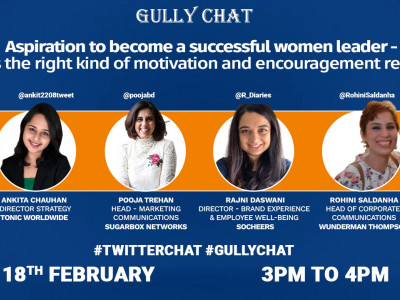The W-Suite: Rajni Daswani
With a rapidly evolving business and economic landscape there is a dire requirement of fresh thinking, new skill sets, greater flexibility & adaptability, more collaboration as well as the ability to think on one’s feet.
Diversity in the workforce has become a necessity today, and more so in the leadership positions. It can’t be denied that women bring a high level of creativity and empathy while solving problems and handling crises. Women leaders bring to the table a different level of dexterity.
AdGully’s ‘The W-Suite’ series features interactions with influential women leaders in India, who share some deep insights on what being a woman leader means in India’s business landscape, the mantras to succeed, achieving work-life balance, pay parity and much more.
Rajni Daswani, Director – Brand Experience & Employee Engagement, SoCheers Infotech, is the only woman leader amongst the three partners at SoCheers. Her role involves everything – from brand building to employee engagement to looking into ideation and bringing in new clients. Daswani has been proved to be a noticeable personality in shaping the company that SoCheers is today.
Daswani started her career as a Financial Analyst, specialising in macro-economic and commodities with Anand Rathi and Motilal Oswal. After working for 3 years in the finance industry, she took a leap of faith to step up in the entrepreneur world with her own clothing label – Azraa. However, due to a lot of personal and professional issues, she chose to shut it down in two years.
She then took her chances into a completely different domain of communication world by landing her first stint as a PR Executive at Perfect Relations, which gave her an exposure to several leading corporate and finance brands. While working in the PR industry, she realised that the digital industry is booming, which led her to start a new journey in the digital marketing firm – SoCheers – in the year 2014.
What defines a woman leader in today’s ecosystem?
A woman leader is strong, powerful, positive, fierce and balanced. She embraces her individuality, is humble enough to acknowledge her failures and is confident enough to make mistakes and learn from them. She’s willing to change and evolve with times, and believes in sharing and empowering others. A woman is also open, speaks her mind and is empathetic. She takes risks and seizes opportunities. She’s a leader and understands the baggage that comes with it.
Why do you think a smaller percentage of women than men reach the top of their professions?
India has always been a patriarchal society and even though we don’t like it, it will somewhere always continue to be. Even in metro cities and educated families, when the woman must make a choice of focusing her energies at work or at home, 70 per cent still support home. Data shows that women drop off from the workforce at different stages in their life: starting at marriage, moving to having children and also when the husband is earning enough to support the family. If women choose or are forced to give up work at these stages where their careers are just picking up steam, the percentage of women reaching the top becomes very less.
What would help this percentage grow is support from family and friends and support and understanding by employers. We need a lot more women empowering other women to go out there and make a difference. Another thing that would help is women not feeling guilty for picking their careers over families – I think a lot of women give in to the pressure at home or work because of this self-depreciating guilt.
Do you think women leaders are still scrutinised as much for style as for substance?
Style and substance usually go hand in hand. It’s more like choosing between the two in different circumstances. Women leaders are scrutinised for everything they do. If they have substance, they’ll be scrutinised for style and vice versa. The idea is to stop worrying about being scrutinised – negatively or positively. If you are working towards doing better than you did before, evolving, showing up and taking responsibilities, you don’t need to be worry about scrutiny. And if you want to worry about being scrutinised, do it for yourself. Review yourself against your goals and use it to drive your goals further.
Do you think the leadership effectiveness of women is higher than men? Why?
A lot of the leadership effectiveness depends on the leadership style than the gender. How you handle the team – which should ideally be a mix of empathy and firmness – is what takes prime focus and that’s where your gender bifurcation goes off. Women are generally known to be more empathetic, which makes them more approachable and flexible as leaders. But then men find it easier to hold authority. So, it’s really a mixed debacle.
Women leaders in the 80’s and 90’s and women leaders today – what are the key differences? And what are the things that haven’t changed much?
Women leaders back in the days had to fight for everything – fight at home to go out and work, fight at work to be recognised, fight against the whole patriarchal system which is focused towards men. Today, thanks to globalisation, education and awareness, women have a stronger platform to stand on. We can expect to at least get an equal opportunity at proving ourselves – at school, at work and even at home.
You’ve really got to look up to the women leaders or even celebrities who kept their stance even when the world rallied around them with negativity and tried pulling them down. We have it a lot easier than them.
But the one thing that hasn’t changed is that even today a woman leader will have to do a lot more to prove herself than her male counterpart. While the platform is equal, the judgement is not.
How do you maintain a balance between career goals and family responsibilities? How frequently do you have to sacrifice one for the other?
To be honest, I haven’t taken up any family responsibilities yet. My family has been super supportive of all my career choices and always pushes me to achieve more than I aimed. I’m single and want to do as much as possible with my career before I get my share of family responsibilities. However, I am quite confident that even with sacrifices, my family will always be supportive of my career decisions.
Do you think pay parity exists in our corporates today across levels? What about pay parity at the leadership levels?
Yes, pay parity exists – in corporates, in Bollywood, in start-ups, in blue collared jobs, everywhere. People don’t reckon women to be serious about work or money or about supporting a family and hence, in our patriarchal society, pay parity exists at all levels. At leadership levels, it’s lesser than it is at the lower ranks since the number of women at that level is anyway comparatively less. However, change starts at home and also when you ask for what you deserve. If you don’t think you deserve it, it somehow is your fault and not the employers.
What would be your advice to women aiming for the C-suite?
The one and only advice that I would love to give to the women in our society is: Go for it with all your might, give it all that you have and then give some more. Take opportunities, take risks, show up even when you don’t want to, make mistakes, fail, be willing to change and never stop dreaming. Dream of what you want to become and then strive hard to become that person.
What, according to you, are the 3 important lessons new women leaders need to learn?
Lesson 1: Don’t get pressured – When you do something, give it your best. However, don’t get pressured under failure, it’s okay to fail. Failure is only a step towards your success.
Lesson 2: Don’t feel guilty – Whenever you are stepping over someone, winning something over someone else, being firm – don’t feel guilty. You’ve been through a lot to have this moment. Grab it with all you’ve got!
Lesson 3: Pay it forward – The more women leaders in the system, the better this world will be. Make an extra effort to help another woman out, empower them.
To Read More Visit Here.


















Share
Facebook
YouTube
Tweet
Twitter
LinkedIn